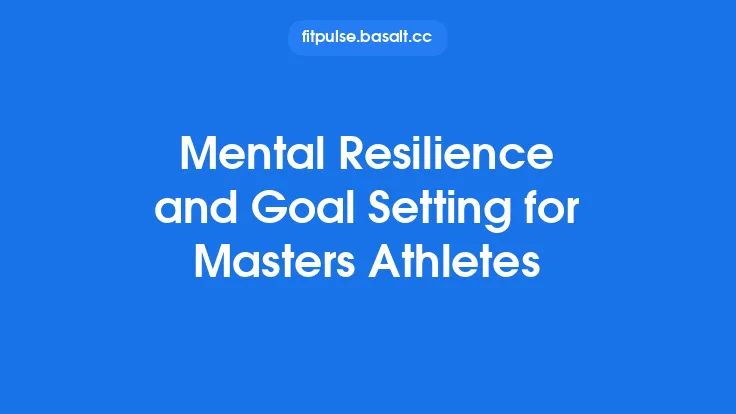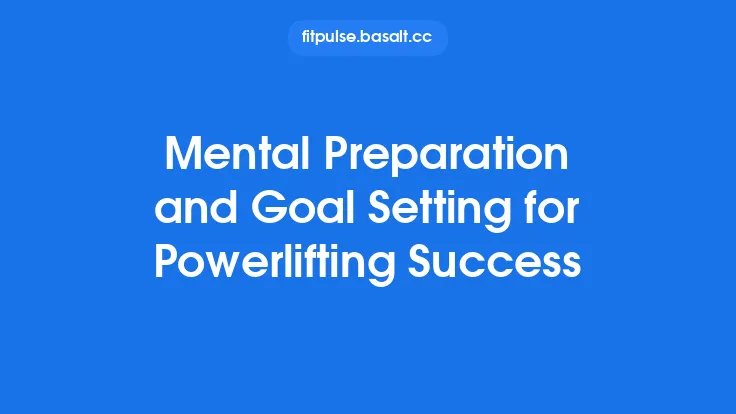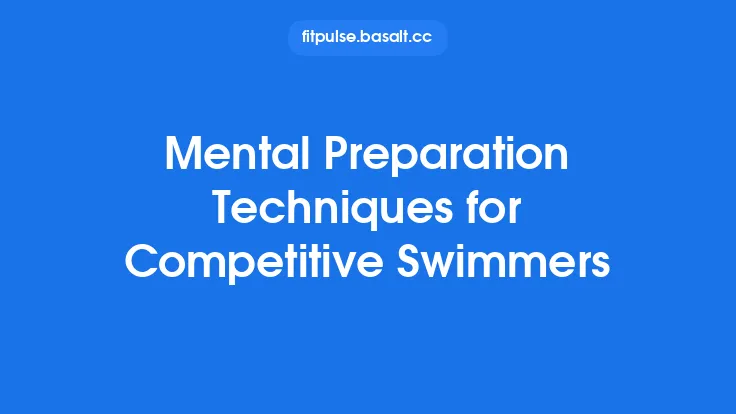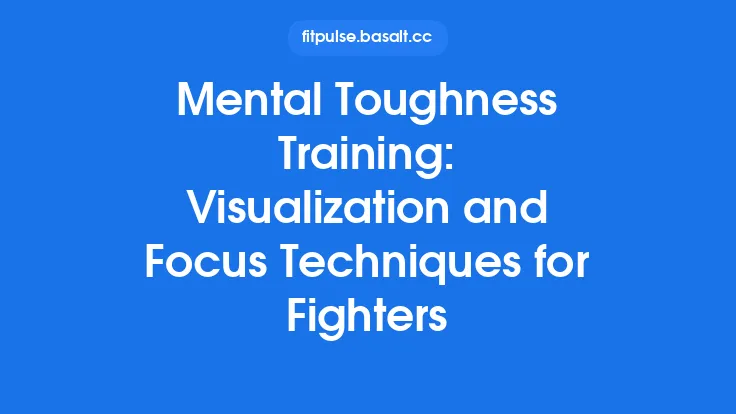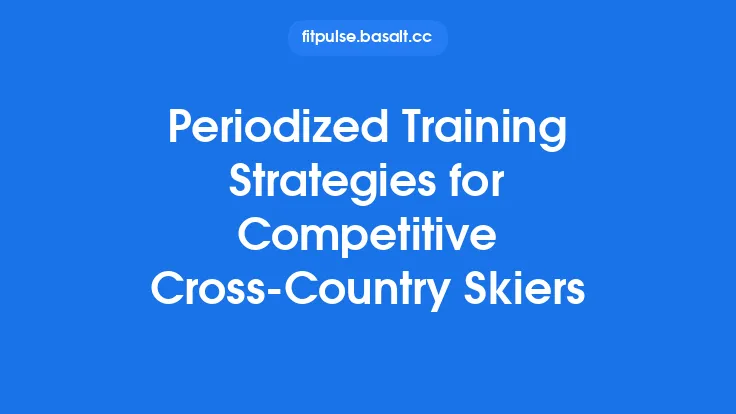Competitive cycling is as much a battle of the mind as it is a test of physical endurance. While miles of training, equipment choices, and nutrition plans lay the foundation for performance, the mental edge often determines who crosses the finish line first. This article explores the core mental skills that elite cyclists use to sharpen focus, set purposeful goals, and execute race‑day strategies with confidence. By integrating these techniques into your regular routine, you can develop a resilient mindset that supports consistent improvement and peak performance on any course.
Understanding the Mental Demands of Competitive Cycling
Cyclists operate in a dynamic environment where split‑second decisions, sustained concentration, and emotional regulation are required for hours on end. The mental demands can be grouped into three primary domains:
| Domain | Typical Challenges | Why It Matters |
|---|---|---|
| Attention & Focus | Maintaining lane position, monitoring competitors, reacting to terrain changes | Loss of focus can lead to missed opportunities or crashes |
| Emotional Regulation | Managing anxiety before a start, coping with frustration from setbacks | Unchecked emotions can cause premature fatigue or poor pacing |
| Cognitive Load | Processing data (e.g., power output, heart rate), planning tactics on the fly | Overload can impair decision‑making and increase perceived effort |
Understanding these demands helps you target specific mental skills for development rather than treating “mental training” as a vague concept.
Goal Setting: Crafting a Roadmap for Success
Effective goal setting transforms vague aspirations (“I want to be faster”) into actionable pathways. The most reliable framework for cyclists is the SMART model, refined for sport psychology:
- Specific – Define the exact performance metric (e.g., “Reduce 20‑km time trial time by 30 seconds”).
- Measurable – Ensure you can track progress with objective data (power, speed, heart rate).
- Achievable – Set a realistic target based on current fitness and training history.
- Relevant – Align the goal with your broader competitive objectives (e.g., qualifying for a national championship).
- Time‑Bound – Attach a deadline (e.g., “by the end of the next 8‑week training block”).
Tiered Goal Structure
- Long‑Term Vision (12‑24 months) – The overarching ambition (e.g., “Podium at a UCI race”).
- Mid‑Term Milestones (3‑6 months) – Intermediate checkpoints that indicate progress toward the vision (e.g., “Consistently hold 250 W for 30 min”).
- Short‑Term Objectives (Weekly/Session) – Daily or session‑level targets that keep you on track (e.g., “Maintain cadence above 90 rpm on climbs”).
By regularly reviewing and adjusting these tiers, you maintain motivation while preventing burnout from overly rigid expectations.
Developing Focus and Concentration
Cycling demands both broad situational awareness (monitoring the peloton, road conditions) and narrow task focus (maintaining power output, pedal technique). Training these attentional skills can be broken down into three practical methods:
- Focused Attention Drills
- Single‑Cue Tracking: During a steady ride, pick a single visual cue (e.g., a roadside marker) and keep your gaze on it for 30‑second intervals, then shift to a new cue. This trains the ability to lock onto relevant information without distraction.
- Auditory Filtering: Use a music playlist with intermittent beeps; each beep signals you to report your current power or heart rate mentally, reinforcing internal monitoring while external sounds compete for attention.
- Sustained Attention Practices
- Progressive Duration: Start with 5‑minute blocks of uninterrupted focus on cadence, gradually extending to 30‑minute blocks. Record perceived effort and any mind‑wandering episodes to identify patterns.
- Mindful Riding: Incorporate a low‑intensity ride where you deliberately observe each pedal stroke, breath, and terrain change without judgment. This cultivates a habit of staying present during longer efforts.
- Switching Attention Efficiently
- Scenario Simulations: Set up a training ride with planned “surprise” events (e.g., sudden hill, a teammate’s attack). Practice quickly shifting from a steady state to a tactical response, noting the mental steps you take to re‑orient.
Consistent practice of these drills builds a mental “muscle” that translates into sharper focus during races, especially when fatigue threatens to erode concentration.
Arousal Regulation and Energy Management
The relationship between physiological arousal (sympathetic nervous system activation) and performance follows an inverted‑U curve, famously described by the Yerkes‑Dodson Law. Too little arousal leads to sluggishness; too much results in anxiety and loss of fine motor control. Cyclists can modulate arousal through three complementary techniques:
- Breathing Strategies
- Box Breathing: Inhale for 4 seconds, hold 4 seconds, exhale 4 seconds, hold 4 seconds. Repeat for 2‑3 minutes before a start or during a high‑stress segment. This stabilizes heart‑rate variability (HRV) and reduces cortisol spikes.
- Diaphragmatic Breathing: During long climbs, focus on deep belly breaths (6‑8 breaths per minute) to maintain oxygen delivery and calm the nervous system.
- Progressive Muscle Relaxation (PMR)
- Prior to a race, systematically tense and release major muscle groups (calves, quads, glutes, shoulders). The physical relaxation cues the brain to lower overall arousal, creating a calm yet alert state.
- Pre‑Performance Routines
- A short, repeatable sequence (e.g., checking bike, visualizing the first 5 km, a specific stretch) signals to the brain that it is time to transition from “training mode” to “competition mode,” helping to lock in the optimal arousal level.
Monitoring HRV or using a simple perceived arousal scale (1‑10) during training can help you fine‑tune these strategies for individual response patterns.
Visualization and Mental Rehearsal
Imagery is a powerful tool that activates neural pathways similar to actual riding, reinforcing motor patterns and tactical decision‑making. Effective visualization follows a structured approach:
- Create a Detailed Script
- Write a narrative of a specific race segment (e.g., “approaching the final 2 km climb”). Include sensory details: the wind on your face, the sound of the peloton, the gradient percentage, your cadence, and power output.
- Multi‑Modal Imagery
- Visual: Picture the road, your position, competitors.
- Kinesthetic: Feel the pedal stroke, the tension in your legs.
- Auditory: Hear the chain, crowd, and your own breathing.
- Emotional: Anticipate the excitement or pressure and rehearse staying calm.
- Timing and Frequency
- Perform a 5‑minute session daily, focusing on different race scenarios each week. Prior to a key event, intensify to 10‑minute sessions, ideally after a light physical warm‑up to enhance neural priming.
Research shows that athletes who regularly engage in vivid, sport‑specific imagery improve both confidence and execution under pressure. For cyclists, visualizing gear changes, cornering lines, and sprint finishes can translate into smoother, more decisive actions on the road.
Self‑Talk and Cognitive Restructuring
The internal dialogue you maintain during training and competition can either amplify performance or sabotage it. Self‑talk is the conscious manipulation of this dialogue, while cognitive restructuring addresses deeper belief systems that drive negative thoughts.
Steps to Optimize Self‑Talk
| Step | Action | Example |
|---|---|---|
| Identify | Notice recurring negative phrases (“I’m too slow”). | During a hard interval, you think “I can’t keep this pace.” |
| Challenge | Question the evidence behind the thought. | “I’ve held this power for 10 minutes before; why not now?” |
| Replace | Insert a constructive alternative. | “I’m strong enough to maintain my target power.” |
| Reinforce | Repeat the new phrase during training until it feels natural. | Use a mantra like “Smooth and steady” on long climbs. |
Cognitive Restructuring Techniques
- Thought Records: Log a stressful race moment, the automatic thought, the emotional response, and a balanced counter‑thought. Review weekly to detect patterns.
- Socratic Questioning: Ask yourself, “What would I tell a teammate in this situation?” This external perspective often reveals overly harsh self‑criticism.
- Growth Mindset Framing: Shift from “I failed this sprint” to “I learned how my body reacts at 900 W; I can adjust my pacing next time.”
By systematically reshaping internal narratives, cyclists develop a mental environment that supports persistence and confidence.
Pre‑Race Routine: Setting the Mental Stage
A well‑crafted pre‑race routine creates a psychological “launch pad” that primes focus, reduces anxiety, and aligns your mental state with the race plan. The routine should be:
- Consistent: Perform the same sequence before every competition to build automaticity.
- Time‑Efficient: Fit within the window between arrival at the start line and the official start (typically 30‑45 minutes).
- Personalized: Include elements that resonate with you (music, specific stretches, a brief meditation).
Sample Pre‑Race Routine (35 minutes total)
| Time | Activity | Purpose |
|---|---|---|
| 0‑5 min | Arrival, bike check, quick visual scan of the course | Grounding, situational awareness |
| 5‑10 min | Light dynamic warm‑up (leg swings, hip circles) | Increase blood flow, reduce stiffness |
| 10‑15 min | Breathing & PMR (Box breathing + shoulder tension release) | Lower arousal, increase focus |
| 15‑20 min | Goal reminder (review short‑term objective and race strategy) | Cognitive priming |
| 20‑25 min | Visualization of first 10 km (including terrain, pacing) | Neural rehearsal |
| 25‑30 min | Mantra repetition (“Strong, steady, forward”) | Self‑talk reinforcement |
| 30‑35 min | Final equipment check, hydration sip, line‑up positioning | Physical readiness, confidence boost |
Adjust the timing to suit your personal preferences and the specific race format (criterium vs. road race vs. time trial).
In‑Race Mental Strategies
Once the race is underway, mental skills must be applied in real time. Below are proven tactics for different race phases:
1. Early Phase – Establishing Position
- Anchor Cue: Choose a simple cue (e.g., “breath in, breath out”) to keep your breathing rhythmic while scanning for gaps.
- Micro‑Goals: Set immediate, achievable targets (e.g., “Stay within the top 20 for the first 5 km”). This prevents overwhelm from the overall distance.
2. Mid‑Race – Managing Fatigue and Tactics
- Chunking: Break the remaining distance into manageable segments (e.g., “Next 10 km”). Focus on one chunk at a time, updating your internal map after each.
- Re‑framing Discomfort: When lactic acid builds, reinterpret the sensation as “fuel for power” rather than “pain”. Pair this with a quick self‑talk cue (“Push, don’t quit”).
- Opponent Modeling: Briefly assess a rival’s body language and power cues, then decide whether to follow, attack, or conserve. Keep this assessment under 5 seconds to avoid analysis paralysis.
3. Final Phase – Sprint or Finish
- Pre‑Sprint Countdown: Use a 3‑2‑1 mental countdown to trigger a surge in arousal, aligning with the physiological need for a final power burst.
- Focus Funnel: Narrow attention to a single point (e.g., the finish line) while maintaining peripheral awareness of competitors. This “tunnel vision” enhances power output without sacrificing safety.
- Positive End‑State Visualization: In the last 200 m, picture crossing the line with a strong, controlled effort. This reinforces confidence and reduces the risk of “hitting the wall”.
Post‑Race Reflection and Learning
The mental work does not end at the finish line. Structured reflection consolidates learning and informs future goal setting.
- Immediate Debrief (within 30 min)
- Write down three objective observations (e.g., “Held 260 W for 15 km on the climb”).
- Note two emotional responses (e.g., “Felt anxious at the start”).
- Detailed Analysis (24‑48 hr later)
- Review data (power, heart rate) alongside mental notes. Identify moments where mental skills either helped or hindered performance.
- Ask: “Did my self‑talk stay positive during the hardest segment?”
- Action Plan
- Choose one mental skill to refine for the next race (e.g., “Add a 5‑minute visualization of the final sprint”).
- Set a measurable target (e.g., “Practice the sprint countdown cue three times per week”).
Consistent post‑race reflection creates a feedback loop that accelerates mental development just as physiological training does.
Building Long‑Term Mental Resilience
Resilience is the capacity to bounce back from setbacks, maintain motivation during plateaus, and thrive under pressure. Developing it involves both habitual practices and periodic challenges.
Habitual Practices
- Daily Mindfulness: 10‑minute seated meditation focusing on breath or body sensations. Enhances awareness of mental chatter and improves emotional regulation.
- Journaling: Record training moods, perceived stressors, and successes. Over time, patterns emerge that guide adjustments.
- Recovery Mental Rituals: Treat rest days as mental “off‑season” with activities that promote relaxation (reading, nature walks). This prevents burnout.
Periodic Challenges
- Controlled Stress Sessions: During a long ride, deliberately introduce a mental stressor (e.g., a simulated mechanical issue) and practice staying calm while solving it.
- Competitive Simulations: Participate in low‑stakes races or group rides where you can test new mental strategies without high external pressure.
- Skill‑Specific Workshops: Attend a sports psychology seminar or work with a mental performance coach for a focused deep‑dive on a particular skill (e.g., anxiety management).
By weaving these practices into your training calendar, mental resilience becomes as ingrained as muscular endurance.
Integrating Mental Training into Your Overall Plan
To ensure mental skills receive the same systematic attention as physical training, embed them into your weekly schedule:
| Day | Physical Focus | Mental Focus |
|---|---|---|
| Monday | Recovery ride (60 min, low intensity) | 10‑min mindfulness + journal entry |
| Tuesday | Interval session (VO₂ max) | Pre‑session visualization of interval pacing |
| Wednesday | Endurance ride (3‑4 h) | In‑ride focus drills (cue‑based attention) |
| Thursday | Strength & core (off‑bike) | Self‑talk script rehearsal |
| Friday | Tempo ride (2 h) | Arousal regulation breathing before start |
| Saturday | Race simulation or group ride | Full pre‑race routine + post‑ride reflection |
| Sunday | Long ride (4‑5 h) | Mid‑ride mental check‑ins (body scan) |
Treat each mental activity as a non‑negotiable training block. Over weeks and months, the cumulative effect mirrors that of a well‑structured physical program, leading to measurable improvements in race performance.
Key Takeaways
- Goal setting provides a clear roadmap; use SMART, tiered goals to keep progress tangible.
- Focus drills and attention training sharpen the ability to stay present during long, demanding rides.
- Arousal regulation (breathing, PMR, routines) aligns physiological readiness with mental calm.
- Visualization and self‑talk rewire neural pathways and reinforce confidence.
- Pre‑race routines and in‑race mental tactics translate practiced skills into real‑world performance.
- Post‑race reflection closes the learning loop, informing future mental and physical adjustments.
- Resilience building through daily habits and periodic challenges ensures long‑term mental health and competitive edge.
By deliberately cultivating these mental skills, competitive cyclists can unlock a level of performance that complements their physical training, turning every ride—and every race—into an opportunity for growth and success.
